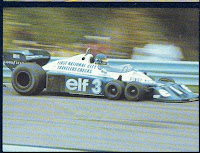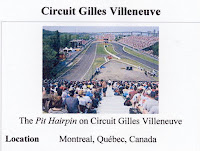Just before the turn of the century, the first race of man and road machine was held between Paris and Bordeaux and back, 732-miles, on June 13, 1895. It took just under49 hours at a speed of approx. 15 miles per hour. It attracted 102 entries.It was won by Emile Levassor. His car was a two-cylinder, 750 rpm, four horsepower Daimler engine Those were years of great hopes and innovations.
The second era was between the two great wars. Young men (and a few young women) were stirred by a sense of adventure and nationalistic fervour.
After the Second World War auto racing became an international sport of mass appeal.
Early races required drivers with tremendous courage, skill and brute strengh to handle the huge machines, which in 1908 for example, were allowed to weigh up to 2425 lbs.
In 1914, with engines limited to 4.5 litres, the most exciting race was considered the Grand Prix of France at Lyon. French hero, Georges Boillot fought off a pack of German drivers until the last lap when his Peugeot broke down.
The first major race after World War 1 was the 1919 Taraga Florio in the mountainous Sicilian countryside. The first car off the line was driven by one Enzo Ferrari. Ferrari founded Ferrari S.P.A. in 1947
One of the most succesful racing cars was the Mercedes W125. It was driven to victory in seven of the 12 races it entered. The super-charged 5.6 litre power plant developed 600 horsepower.
Just before the Second World War, the keenest competition was between the Germans and the Italians. German Auto Union and Mercedes (Gr.) against Alfa Romeo and Maseratis (Ita).
Many considered Tazio Nuvolari the greatest of all. The wiry Italian repeatedly routed the superior German teams. Nuvolari signed with the Germans and became an Auto Union driver. He won a few races after the war.
At the end of World War 2 motor racing took years to fully recover. There was a Grand Prix in Spain in 1946 and in 1947 events in Switzerland, Belgium and Italy.
A young Argentine named Juan Fangio was bashing stock cars through the mountains of South America getting experience that would make him one of the world's greatest drivers.
In England a boyish Stirling Moss was entering hill climbs in a Cooper 500. Young Colin Chapman had modified the family Austin to go racing across the fields of Kent.
Early Chapman
Special
And in Canada, enthusiasts raced their Morris Minors and MG's around abandoned airport.(Actually, I entered my 1960 MG at Harwood Acres near Goderich, Ontario, Canada)
In 1967, an Australian Jack Brabham won the first Canadian Grand Prix at Mosport, Ontario.
1950 was a key year. The World Championship for Formula One was initiated. Itanians dominated until John Cooper's little cars started to come through for Britain in 1959. From then on Grand Prix racing had been a British affair with Ferrari getting an occasional win and French Matra winning once.
The use of the Coventry-Climax engine brought the British 96 major race wins between 1958 and 1966. This was a little lightweight engine designed for use as a water pump by firefighters.
Would Moss beat Hawthorn? Could Collins take Fangio in an equal car? And later, what about the new guys Brabham and Jill and the young guys like Surtees, Amon, Clark, Hume, McLaren, Stewart and Rindt.
John Surtees
Denis Hume
Then the really new guys, Lauda, Fittipaldi, Hunt, Andretti and the guys of the future Amoux, Rosberg, Villeneuve, Pironi
Villeneuve
Emmerson Fittipaldi
Nico Rosberg
The drivers were becoming businessmen using modern methods, just as the cars were being developed with space age techniques to go faster each year with smaller engines.
1978 CANADIAN GRAND PRIX, MONTREAL
(before it was called Circuit Gilles Villeneuve
As the eighties approach, a new era is on the way
with a new dimension added. Monaco, long a Grand Prix favourite is
being emulated. Race tracks in the heart of Metropolitian areas. With the opening of the magnificent new Circuit Gilles Villeneuve, Montreal, one Metro stop from downtown Montreal, auto racing now becomes a sport for everyone.































No comments:
Post a Comment